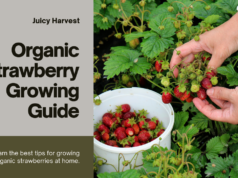
Welcome to our comprehensive guide on planting and growing grapes in your backyard. Whether you’re a seasoned gardener or a beginner, this step-by-step guide will equip you with the knowledge and techniques to cultivate your own grapevines and enjoy the bountiful harvest they offer.
Planting and growing grapes is not only a rewarding hobby, but it also allows you to enjoy the freshness and flavor of homegrown grapes. With a little planning and care, you can transform your backyard into a thriving vineyard, producing delicious grapes for your family and friends to enjoy.
Key Takeaways:
- Select the right grape variety for your region based on climate and soil conditions.
- Proper soil preparation is essential for successful grape cultivation.
- Provide your grapevines with adequate care, including watering, fertilizing, and pruning.
- Learn to identify and manage common pests and diseases in grapevines.
- Harvest grapes when they are ripe and store them properly for long-lasting freshness.
Selecting the Right Grape Variety for Your Region
Before you start planting your grapevines, it’s important to choose the right grape variety for your specific region. The success of your backyard vineyard depends on selecting grape varieties that are well-suited to the climate and soil conditions in your area.
When it comes to grape varieties, there are many options to choose from, each with its own unique characteristics and requirements. Some varieties thrive in cooler climates, while others prefer warmer regions. Certain grapes are better suited for making wine, while others are perfect for fresh eating or drying into raisins.
So, how do you go about selecting the right grape variety for your region? Consider the following factors:
- Climate: Different grape varieties have varying temperature and humidity requirements. Some grapes perform best in regions with long, warm summers, while others can tolerate cooler climates with shorter growing seasons. Research the climate conditions in your area to identify grape varieties that are known to thrive in similar environments.
- Soil: The type of soil in your region will also play a crucial role in determining which grape varieties are suitable for cultivation. Grapes can tolerate a wide range of soil types, including sandy, loamy, and clay soils. However, certain varieties may have specific soil preferences. Understanding your soil’s composition and pH level will help you select grape varieties that will grow well in your garden.
- Purpose: Consider your goals for growing grapes. Are you interested in making wine? If so, you’ll want to choose grape varieties that are known for their wine-making potential. Alternatively, if you’re planning to enjoy fresh grapes or make grape juice, there are specific table grape varieties that offer exceptional flavor and sweetness.
By taking into account these key factors, you’ll be able to narrow down the grape varieties that are most likely to thrive in your region. Look for varieties that are well-adapted to your specific climate and soil conditions, and align with your goals for growing grapes.
Remember, selecting the right grape variety for your region is the first step towards a successful backyard vineyard. To help you get started, here’s a table showcasing some popular grape varieties and their recommended regions:
| Grape Variety | Recommended Regions |
|---|---|
| Chardonnay | France, California, Australia |
| Cabernet Sauvignon | California, Bordeaux region, Australia |
| Riesling | Germany, France, New York |
| Pinot Noir | Burgundy region, Oregon, New Zealand |
| Muscat | Greece, Italy, Spain |
Keep in mind that this table provides just a glimpse of the many grape varieties available worldwide. Conduct further research and consult with local experts to find the best grape varieties for your specific region.
“The key to a successful grape harvest lies in selecting the right grape variety for your region. By choosing varieties that are well-suited to your climate and soil conditions, you’ll set yourself up for a fruitful vineyard.” – Expert Grape Grower
Now that you understand the importance of selecting the right grape variety for your region, you’re ready to move on to the next step: preparing the soil and planting your grapevines. But first, take a moment to appreciate the beauty of a well-tended grapevine:
Preparing the Soil and Planting Grapevines

The key to successful grape growing lies in preparing the soil and planting your grapevines correctly. The quality of the soil and the proper planting techniques are vital for the optimal growth and health of your grapes. Follow these soil preparation techniques and step-by-step guidelines to ensure your grapevines have the best start:
- Choose a suitable location: Select a sunny spot in your backyard with well-draining soil. Grapes thrive in locations with full sun exposure for at least 6 hours a day.
- Test the soil: Conduct a soil test before planting to determine its pH level and nutrient content. Grapes prefer slightly acidic soil with a pH range of 5.5 to 7.0.
“The quality of the soil and the proper planting techniques are vital for the optimal growth and health of your grapes.”
| Soil Preparation Techniques | Steps for Planting Grapevines |
|---|---|
|
|
By following these soil preparation techniques and planting guidelines, you’ll give your grapevines the best possible start for growth and productivity. Remember to provide regular care and maintenance to ensure healthy vines and a bountiful harvest.
Providing Adequate Care and Maintenance for Grapevines
Once you’ve planted your grapevines, it’s essential to provide them with the proper care and maintenance to ensure their healthy growth and abundant fruit production. By implementing effective watering, fertilizing, and pruning techniques, you can nurture your grapevines to thrive in your backyard vineyard.
Watering Techniques
Water is crucial for grapevines, especially during their early growth stages. Proper watering techniques help establish strong root systems and promote overall plant health. Here are a few tips to keep in mind when watering your grapevines:
- Water thoroughly but infrequently: Deeply water the grapevines’ root zone, ensuring the water penetrates the soil deeply. However, avoid overwatering, as excessive moisture can lead to root rot.
- Water during dry periods: Grapevines require consistent soil moisture, particularly during dry periods. Monitor the soil moisture levels and water accordingly to maintain optimal moisture levels.
- Consider drip irrigation: Drip irrigation systems deliver water directly to the base of the grapevines, minimizing water waste and maximizing efficiency.
Fertilizing Techniques
Fertilizing your grapevines provides them with the essential nutrients they need for healthy growth and development. Follow these fertilizing techniques to ensure your grapevines receive the right nutrients:
- Soil testing: Conduct a soil test to determine any nutrient deficiencies or imbalances. Based on the results, select a balanced fertilizer formulation suitable for grapevines.
- Fertilize during the growing season: Apply fertilizer in early spring, just as the grapevines begin their active growth. Use a slow-release fertilizer to provide a steady supply of nutrients throughout the season.
- Avoid excessive fertilization: Overfertilization can lead to excessive vegetative growth and reduced fruit production. Follow the recommended application rates and timing specified for grapevines.
Pruning Techniques
Proper pruning is vital for grapevines as it helps maintain their shape, promote good airflow, and encourage fruit production. Follow these pruning techniques to ensure healthy, productive grapevines:
- Prune during dormancy: Prune grapevines during their dormant period, typically in late winter or early spring before bud break. This allows the grapevines to allocate energy efficiently and encourages robust growth.
- Remove old wood: Eliminate any weak or dead wood, as well as the previous season’s fruiting canes, to encourage the growth of new shoots and maintain overall vine health.
- Thin out excess growth: Thin out excessive canes and foliage to improve airflow and light penetration, reducing the risk of diseases and allowing the remaining grapes to receive ample sunlight.
To further understand how to provide the best care and maintenance for your grapevines, consult reputable gardening resources, join local grape-growing communities, or seek guidance from experienced home gardeners. By nurturing your grapevines with proper care and maintenance, you’ll enjoy a flourishing vineyard and a delightful harvest of grapes.
Managing Pests and Diseases in Grapevines
Grapevines are incredibly resilient plants, but they are still prone to pests and diseases that can have a detrimental impact on their health and productivity. To ensure that your grapevines stay healthy and thriving, it’s important to be able to identify, prevent, and control common grapevine pests and diseases.
Common Grapevine Pests
Grapevines can fall victim to a variety of pests that feed on their leaves, stems, and fruit. These pests can weaken the vines, reduce grape quality, and even destroy entire crops if left unchecked. Here are some of the most common grapevine pests:
Aphids: These small insects feed on grapevine sap, causing leaves to curl and turn yellow. They can also transmit viruses that can affect the overall health of the vine.
Grape Berry Moth: The larvae of this moth feed on grape berries, creating small holes and causing the fruit to rot. This can significantly reduce the quality and yield of the harvest.
Spider Mites: These tiny pests can cause webbing on grape leaves, stunting growth and reducing the vine’s ability to photosynthesize effectively.
Japanese Beetles: These beetles feed on grape leaves, causing skeletonization and defoliation of the vine if left untreated.
Common Grapevine Diseases
Grapevines are also susceptible to various diseases that can negatively impact their growth and fruit production. These diseases can spread quickly and are often difficult to eradicate. Here are some common grapevine diseases to watch out for:
Powdery Mildew: This fungal disease appears as a white powdery coating on the leaves, stems, and fruit of grapevines. It can inhibit photosynthesis and reduce grape quality.
Downy Mildew: Another fungal disease, downy mildew causes yellow spots on grape leaves and a fuzzy growth on the undersides. It can lead to defoliation and reduced fruit production.
Black Rot: Black rot causes dark, circular lesions on grape berries, which eventually shrivel and turn black. It can lead to complete fruit loss if not managed effectively.
Leafroll Virus: This viral disease causes the leaves of infected grapevines to turn red or purple. It can reduce the vine’s ability to photosynthesize and affect fruit quality.
To effectively manage pests and diseases in grapevines, it’s important to take a proactive approach. Regularly inspect your vines for signs of pest or disease infestation and implement appropriate prevention and control measures. This can include cultural practices, such as maintaining proper vineyard hygiene, as well as the targeted use of organic or chemical treatments when necessary.
By staying vigilant and implementing preventive measures, you can ensure that your grapevines remain healthy and productive, allowing you to enjoy a bountiful harvest of delicious grapes.
| Pest | Description | Prevention | Control |
|---|---|---|---|
| Aphids | Small insects that feed on grapevine sap, causing leaf curling and yellowing | Regularly inspect and remove infested leaves, encourage natural predators | Apply insecticidal soap or neem oil, use targeted chemical insecticides if necessary |
| Grape Berry Moth | The larvae feed on grape berries, causing holes and fruit rot | Properly dispose of fallen fruit, use pheromone traps to monitor and control populations | Apply insecticides during critical periods, prune and remove infested clusters |
| Spider Mites | Small arachnids that cause webbing on grape leaves and stunt growth | Maintain proper vineyard hygiene, promote beneficial insects | Apply horticultural oil or insecticidal soap, introduce predatory mites |
| Japanese Beetles | Feed on grape leaves, causing skeletonization and defoliation | Plant companion plants that deter Japanese beetles, use pheromone traps | Apply insecticides during peak activity, handpick and destroy beetles |
Harvesting and Storing Grapes
One of the most rewarding parts of growing grapes is harvesting the delicious fruits of your labor. After months of nurturing your vines, it’s time to reap the rewards and enjoy the flavorful grapes you’ve cultivated. But how do you know when it’s the right time to harvest? And what steps should you take to ensure that your grapes stay fresh and flavorful during storage? Let’s explore the art of harvesting and storing grapes to make the most of your harvest.
Indicators of Grape Ripeness
Knowing when your grapes are ripe for harvesting is essential. Here are some indicators to look out for:
- The color of the grape berries: Different grape varieties exhibit different colors when they are ripe. For example, white grape varieties may turn from green to a golden hue, while red varieties may deepen in color.
- Taste: Take a few sample grapes and taste them to determine if they have reached the desired level of sweetness.
- Texture: Ripe grapes are firm but not too hard. You can gently squeeze a few grapes to assess their texture.
It’s important to note that different grape varieties have different ripening periods, so consult the specific information for your chosen variety to determine the optimal harvest time.
Proper Harvesting Techniques
When it comes to harvesting grapes, care is crucial to avoid damaging the delicate fruit. Follow these guidelines for a successful harvest:
- Use clean, sharp pruning shears or scissors to cut the grape clusters from the vine. Avoid pulling on the grapes, as this may damage the vine.
- Harvest during cool mornings or evenings to minimize grape dehydration and maintain their quality.
- Handle the grape clusters carefully to prevent bruising or crushing the grapes.
- Place the harvested grapes gently in shallow containers or baskets to avoid squishing them.
Remember, gentle handling and care during harvest will ensure that your grapes remain in top condition.
Storing Grapes Properly
Once harvested, it’s important to store your grapes properly to maintain their flavor and freshness. Follow these tips:
- Remove any damaged grapes or clusters before storing.
- Store grapes in a perforated plastic bag or airtight container in the refrigerator.
- Do not wash the grapes until you’re ready to use them to prevent moisture that can lead to spoilage.
- Keep grapes away from other fruits that release ethylene gas, such as apples and bananas, as this can accelerate ripening and spoilage.
With proper storage, your harvested grapes can last up to a week or longer, allowing you to enjoy their delicious flavor and sweetness at your own pace.
| Harvesting Tips | Storage Tips |
|---|---|
| 1. Harvest grapes when they are ripe and exhibit the desired flavors and texture. | 1. Remove any damaged grapes or clusters before storing. |
| 2. Use clean cutting tools to avoid damaging the vines. | 2. Store grapes in a perforated plastic bag or airtight container in the refrigerator. |
| 3. Handle the grape clusters with care to avoid bruising or crushing the grapes. | 3. Avoid washing the grapes until ready to use to prevent moisture buildup. |
| 4. Harvest during cool mornings or evenings to maintain grape quality. | 4. Keep grapes away from fruits that release ethylene gas, such as apples and bananas. |
By following these harvesting and storage techniques, you can savor the delicious flavors of your homegrown grapes long after the harvest. Enjoy the fruits of your labor and share the bounty of your vineyard with friends and family.
Benefits of Growing Grapes at Home

Growing grapes at home offers a host of benefits that go beyond the satisfaction of having your own vineyard. Whether you’re a wine enthusiast or simply enjoy the sweet taste of fresh grapes, home cultivation provides a rewarding experience for both hobbyists and avid gardeners. Let’s explore the numerous advantages of growing grapes in your own backyard:
1. Fresh, Flavorful Grapes
When you grow grapes at home, you have access to the freshest and most flavorful fruits right at your doorstep. Commercially grown grapes often lose some of their sweetness and juiciness during transportation and storage. By cultivating your grapes, you can enjoy the full spectrum of flavors and aromas that each variety offers, enhancing your culinary experience.
2. Beauty and Privacy
A vineyard in your backyard not only provides a beautiful and picturesque landscape but also adds privacy to your outdoor space. Grapes can be trained to grow on arches, trellises, or pergolas, creating natural walls and barriers that shield you from prying eyes. Transform your garden into a private oasis and a feast for the eyes with the lush vines and vibrant grape clusters.
3. Environmental Friendliness
Growing your grapes at home contributes to a greener and more sustainable environment. By reducing the demand for commercially grown grapes transported over long distances, you minimize carbon emissions associated with transportation. Additionally, home cultivation allows you to control and minimize the use of chemical pesticides and fertilizers, promoting a healthier ecosystem for pollinators and other beneficial organisms.
4. Cost Savings
By growing grapes in your backyard, you can save money on store-bought grapes, especially if you consume them regularly. The initial investment in grapevines and necessary supplies may seem significant, but over time, the cost per pound of homegrown grapes will be much lower. Plus, you have the added benefit of knowing exactly how your grapes were grown, ensuring their quality and freshness.
5. Gardening Enjoyment and Physical Activity
Home cultivation of grapes provides an enjoyable and rewarding hobby that gets you outdoors and active. Tending to your grapevines, pruning, training, and harvesting can be a therapeutic and fulfilling experience. Not only will you be rewarded with a bountiful harvest, but also the opportunity to unwind, connect with nature, and stay physically active.
“Growing grapes at home offers a host of benefits that go beyond the satisfaction of having your own vineyard.”
In summary, growing grapes at home offers a multitude of benefits, from the pleasure of savoring fresh, flavorful grapes to enhancing the aesthetics and privacy of your outdoor space. By cultivating your grapes, you contribute to a more sustainable environment, save money, and enjoy the therapeutic joys of gardening. Embrace the art of home cultivation, and unlock the delightful rewards it brings.
FAQ
Q. How do I select the right grape variety for my region?
A. Selecting the right grape variety for your region involves considering the climate and soil conditions. Look for varieties that are known to thrive in your specific climate and soil type. You can consult local agricultural extension offices or experienced growers in your area for recommendations.
Q. What are the soil preparation techniques for planting grapevines?
A. Before planting your grapevines, ensure the soil is well-drained and fertile. Remove any weeds or grass from the planting area and incorporate organic matter, such as compost or aged manure, to improve soil fertility. Perform a soil test to determine if any additional amendments are needed based on the nutrient levels and pH of the soil.
Q. How do I care for and maintain my grapevines?
A. To care for your grapevines, provide them with regular watering, especially during dry periods. Fertilize annually with a balanced grapevine fertilizer according to the instructions. Prune your vines in late winter or early spring to remove dead or damaged wood and promote fruit production. Regularly monitor for pests and diseases and take appropriate actions to control them.
Q. What are common pests and diseases that affect grapevines?
A. Grapevines can be affected by pests such as aphids, mealybugs, and grapevine moth caterpillars, as well as diseases like powdery mildew, downy mildew, and black rot. Regularly inspect your vines for signs of infestation or disease, and take prompt action to prevent their spread. Implement cultural practices such as proper pruning and removing fallen leaves to reduce the likelihood of disease development.
Q. How do I know when my grapes are ready to be harvested?
A. Grapes are typically ready for harvest when they have reached their desired sugar content, which can be determined by testing the grapes with a refractometer or by tasting the fruit. The grapes should have a good balance of sweetness and acidity. Look for changes in color, firmness, and flavor as indicators of ripeness. Follow specific guidelines for different grape varieties, as their ripening times may vary.
Q. How should I store the grapes after harvest?
A. After harvest, grapes should be stored in the refrigerator to maintain their freshness. Place them in a breathable plastic bag or container to prevent moisture accumulation. Avoid washing the grapes until you are ready to consume them, as excess moisture can promote spoilage. Grapes can typically be stored for several days to a week, depending on their variety and freshness at the time of harvest.
Q. What are the benefits of growing grapes at home?
A. Growing grapes at home offers numerous benefits. You can enjoy freshly harvested grapes that are often sweeter and more flavorful than store-bought ones. It also allows you to have control over the use of pesticides and chemicals, promoting a healthier and more organic approach to fruit cultivation. Additionally, growing grapes can enhance the aesthetics of your outdoor space, providing a beautiful vineyard-like setting.
Conclusion
Growing grapes in your own backyard is a truly satisfying and fulfilling experience. Not only do you get to enjoy the delicious fruits of your labor, but you also gain a deep appreciation for the process of cultivation. By following our expert tips and techniques, you can ensure a successful grape harvest year after year.
Whether you’re a beginner or an experienced gardener, understanding the right knowledge and techniques is key to achieving the best results. From selecting the right grape variety for your region to providing proper care and maintenance, every step is crucial in fostering healthy vines and flavorful grapes.
With dedication and patience, you can transform your backyard into a thriving vineyard. Imagine the joy of picking ripe grapes from your very own vine and savoring their delicious flavors. So, why wait? Start your grape-growing journey and experience the joys of home cultivation today!
















